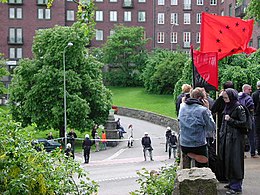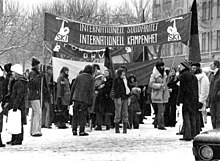
Syndicalism is a revolutionary current within the labour movement that, through industrial unionism, seeks to unionize workers according to industry and advance their demands through strikes and other forms of direct action, with the eventual goal of gaining control over the means of production and the economy at large through social ownership.
Anarcho-syndicalism is an anarchist organisational model that centres trade unions as a vehicle for class conflict. Drawing from the theory of libertarian socialism and the practice of syndicalism, anarcho-syndicalism sees trade unions as both a means to achieve immediate improvements to working conditions and to build towards a social revolution in the form of a general strike, with the ultimate aim of abolishing the state and capitalism. Anarcho-syndicalists consider trade unions to be the prefiguration of a post-capitalist society and seek to use them in order to establish workers' control of production and distribution. An anti-political ideology, anarcho-syndicalism rejects political parties and participation in parliamentary politics, considering them to be a corrupting influence on the labour movement. In order to achieve their material and economic goals, anarcho-syndicalists instead practice direct action in the form of strike actions, boycotts and sabotage. Anarcho-syndicalists also attempt to build solidarity among the working class, in order to unite workers against the exploitation of labour and build workers' self-management.
The International Workers' Association – Asociación Internacional de los Trabajadores (IWA–AIT) is an international federation of anarcho-syndicalist labor unions and initiatives.
According to different scholars, the history of anarchism either goes back to ancient and prehistoric ideologies and social structures, or begins in the 19th century as a formal movement. As scholars and anarchist philosophers have held a range of views on what anarchism means, it is difficult to outline its history unambiguously. Some feel anarchism is a distinct, well-defined movement stemming from 19th-century class conflict, while others identify anarchist traits long before the earliest civilisations existed.

The Swedish Anarcho-Syndicalist Youth Federation, is a youth-based group in Sweden that supports independent working class struggle.

The Zabalaza Anarchist Communist Front, formerly known as the Zabalaza Anarchist Communist Federation (ZabFed), is a platformist–especifista anarchist political organisation in South Africa, based primarily in Johannesburg. The word zabalaza means "struggle" or "active rebellion" in isiZulu, isiXhosa, siSwati and isiNdebele. Initially, as ZabFed, it was a federation of pre-existing collectives, mainly in Soweto and Johannesburg. It is now a unitary organisation based on individual applications for membership, describing itself as a "federation of individuals". Historically the majority of members have been people of colour. Initially the ZACF had sections in both South Africa and Swaziland. The two sections were split in 2007, but the Swazi group faltered in 2008. Currently the ZACF also recruits in Zimbabwe. Members have experienced oppression in South Africa and Swaziland.
The Japanese Anarchist Federation was an anarchist organisation that existed in Japan from 1946 to 1968.
Anarchism in South Africa dates to the 1880s, and played a major role in the labour and socialist movements from the turn of the twentieth century through to the 1920s. The early South African anarchist movement was strongly syndicalist. The ascendance of Marxism–Leninism following the Russian Revolution, along with state repression, resulted in most of the movement going over to the Comintern line, with the remainder consigned to irrelevance. There were slight traces of anarchist or revolutionary syndicalist influence in some of the independent left-wing groups which resisted the apartheid government from the 1970s onward, but anarchism and revolutionary syndicalism as a distinct movement only began re-emerging in South Africa in the early 1990s. It remains a minority current in South African politics.

The Central Organisation of Swedish Workers is a Swedish syndicalist trade union federation. The SAC organises people from all occupations and industries in one single federation, including the unemployed, students, and the retired. The SAC also publishes the weekly newspaper Arbetaren, owns the publishing house Federativ and ran the unemployment fund Sveriges Arbetares Arbetslöshetskassa (SAAK).

The Norwegian Syndicalist Federation is an anarcho-syndicalist group in Norway. Established in the 1910s, the NSF worked within existing Norwegian trade unions in order to radicalise them towards revolutionary syndicalism. It was a founding member of the International Workers' Association (IWA) and historically maintained close connections with the Central Organisation of Swedish Workers (SAC). The NSF was politically repressed during the German occupation of Norway and, in the wake of World War II, experienced a dramatic decline. In the 1970s, the organisation was reconstituted as a propaganda group and continued its activities into the 21st century, with a much smaller membership.

The Argentine anarchist movement was the strongest such movement in South America. It was strongest between 1890 and the start of a series of military governments in 1930. During this period, it was dominated by anarchist communists and anarcho-syndicalists. The movement's theories were a hybrid of European anarchist thought and local elements, just as it consisted demographically of both European immigrant workers and native Argentines.
Anarchism in Japan began to emerge in the late 19th and early 20th centuries, as Western anarchist literature began to be translated into Japanese. It existed throughout the 20th century in various forms, despite repression by the state that became particularly harsh during the two world wars, and it reached its height in the 1920s with organisations such as Kokuren and Zenkoku Jiren.
Contemporary anarchism within the history of anarchism is the period of the anarchist movement continuing from the end of World War II and into the present. Since the last third of the 20th century, anarchists have been involved in anti-globalisation, peace, squatter and student protest movements. Anarchists have participated in armed revolutions such as in those that created the Makhnovshchina and Revolutionary Catalonia, and anarchist political organizations such as the International Workers' Association and the Industrial Workers of the World have existed since the 20th century. Within contemporary anarchism, the anti-capitalism of classical anarchism has remained prominent.
Anarchism in Peru emerged from the Peruvian trade union movement during the late 19th century and the first two decades of the 20th century.
Anarchism in Portugal first appeared in the form of organized groups in the mid-1880s. It was present from the first steps of the workers' movement, revolutionary unionism and anarcho-syndicalism had a lasting influence on the General Confederation of Labour, founded in 1919.
Anarchism in Denmark emerged in the late 19th century from the revolutionary factions of early social democratic spheres, crystalizing into a widespread anarcho-syndicalist movement that reached its height during the late 1910s. After the disintegration of organized syndicalism, anarchists in post-war Denmark began to organize the squatters' movement, which led to the creation of Freetown Christiania.
Anarchism in Austria first developed from the anarchist segments of the International Workingmen's Association (IWA), eventually growing into a nationwide anarcho-syndicalist movement that reached its height during the 1920s. Following the institution of fascism in Austria and the subsequent war, the anarchist movement was slow to recover, eventually reconstituting anarcho-syndicalism by the 1990s.
The Young Socialists was the name of the anarchist and socialist organization that can be said to be responsible for the break, which took place in 1908, between Swedish anarchism and social democracy. It was, among other things, these Young Socialists who took care of the magazine Brand. The Young Socialists were, among other things, behind the formation of the Central Organisation of the Workers of Sweden and the Young Socialist Party. The organization existed until the end of the 1960s, then under the name of the Anarchist Federation.

Helmut Rüdiger (1903–1966) was a German-Swedish journalist and anarcho-syndicalist activist. Born in Saxony, he became involved with the anarchist movement after the German Revolution of 1918–1919, becoming a leading member of the Free Workers' Union of Germany (FAUD). During the 1930s, he moved to Spain, where he participated in the Spanish Revolution of 1936. After the defeat of the Republicans in the Spanish Civil War, he fled to Sweden, where he became a leading member of the Central Organisation of the Workers of Sweden and an influential figure in the "revisionist" tendency of anarcho-syndicalism. He died in Spain in 1966, while trying to make contact with members of the anarchist underground.
The history of anarcho-syndicalism dates back to the anti-authoritarian faction of the International Workingmen's Association. Revolutionary syndicalism as a tendency was constituted in the 1890s by the French General Confederation of Labour (CGT), which became a model union for other syndicalist organisations to base themselves on. Anarchists were involved in the syndicalist movement from the outset and a specific anarchist tendency developed within the movement over the subsequent decades.









